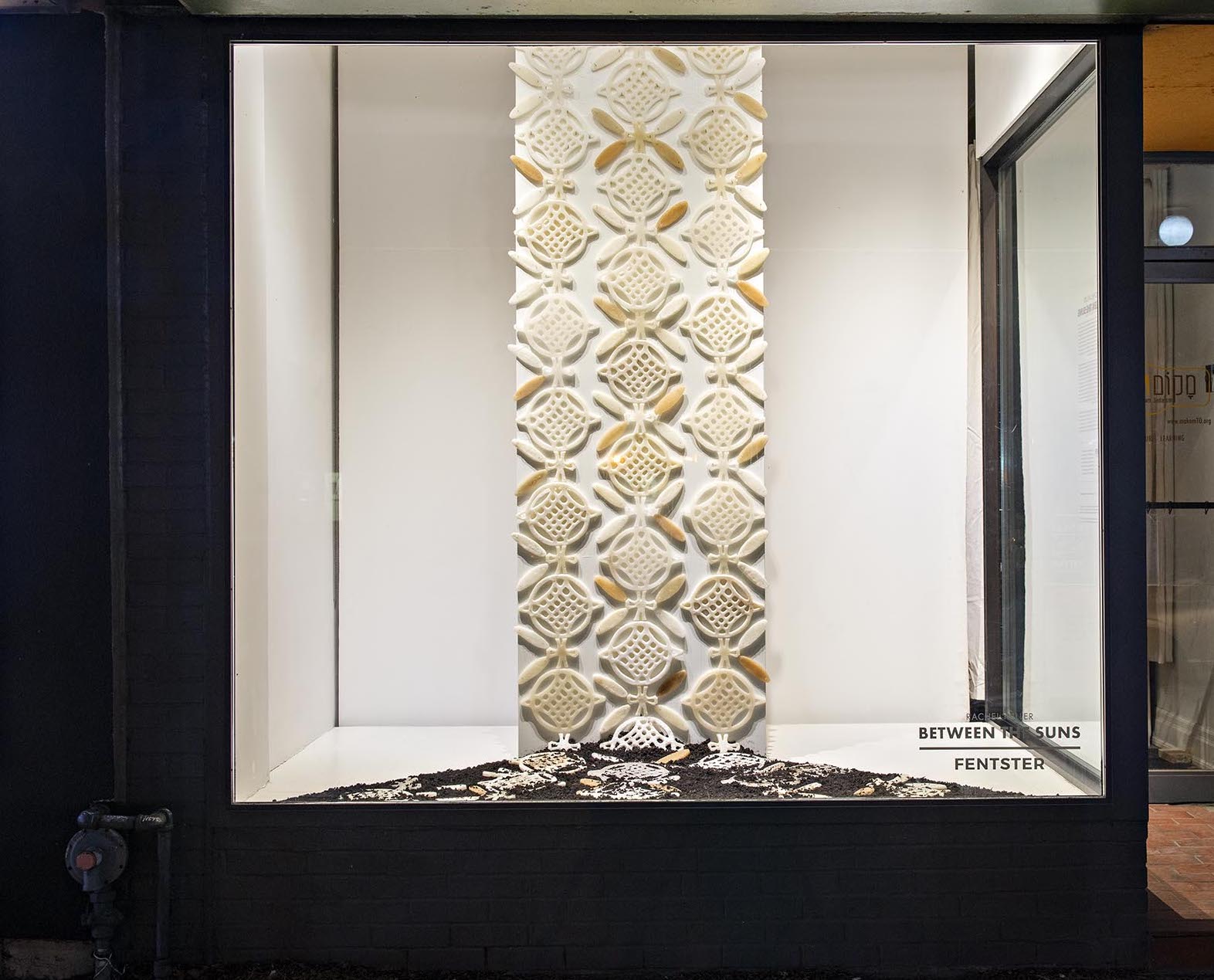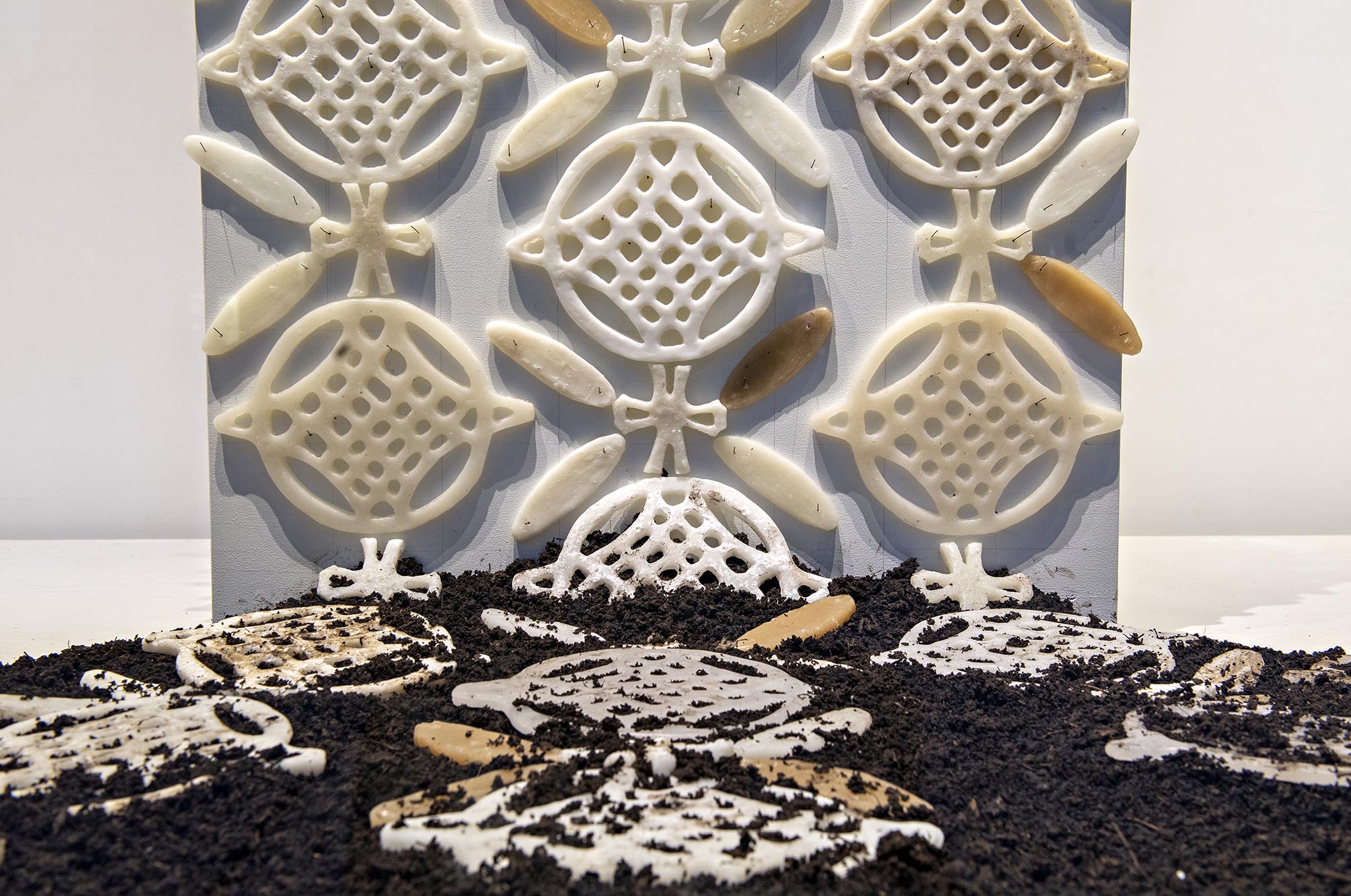
Between the Suns | Rachel Miller interview
Contributed by Abigail Doan
In her latest site-specific, window installation at FENTSTER exhibition space in Toronto, artist, design researcher, and educator, Rachel Miller continues her investigation into timely themes related to environmental fragility, complex pattern as metaphor, and material resilience.
Miller’s sculptural projects and performance-based works have consistently explored the ways that body and landscape overlap to create frameworks for growth, regeneration, and narratives of co-existence. Cycles of nature and ancient traditions have always been touchstones for the artist. Her investigations into historic rituals/texts, archaeology, architecture, and ecological principles have consistently yielded artifact-like garments, soil embedded tapestries, and organic structures rooted in identity and place.

For Between the Suns, the artist expanded her research to the realms of Jewish art and craft traditions as paradigms for community-based and ecological healing. Her current installation at FENTSTER, which opened this past January and remains on view through June 1, 2021, is a multi-dimensional window installation for curious passersby. The textured, wax-cast tapestry forms reference delicate, traditional paper cut borders and speak to the fragility and endurance of heritage, the immigrant experience, and self preservation.
FENTSTER’s curator, Evelyn Tauben, writes that the exhibition's title, Between the Suns is derived from “a Hebrew phrase in Jewish tradition referring to the transitional time of twilight. This exhibition harkens to our present-day limbo – between environmental degradation and the possibility for repair, between life during a pandemic and a new reality on the horizon, between the uncertainty of dusk and the rise of a promising day.”
Having followed the studio practice and artistic journey of Rachel Miller for close to a decade now, I initiated this interview to better understand the new terrain that Miller has ventured into with a community-based social practice and threads of her own family memories. The description of the ‘uncertainty of dusk’ and ‘the rise of a promising day’ also lured me in as possible strategies for how to prevail during these challenging times

AD: Your most recent exhibition is in many ways a continuation of past projects but also ventures into new terrain in terms of materials, process, and historical research. Tell us more about how this site-specific project was conceived and the unique timing of its January 2021 opening.
RM: An exhibition venue like FENTSTER, which means “window” in Yiddish, was ideal for Between the Suns, as the community opening on January 25, 2021, coincided with the Jewish Holiday of Tu Bishvat, also known as the ‘New Year of the Trees’, which for many, has become an engagement opportunity for conscientious care of the environment.
FENTSTER’s curator, Evelyn Tauben and I agreed that having the opening during the week of Tu Bishvat worked well with the project’s theme and commitment to sustainable methods. The gallery installation and sculpture display surface featured environmentally-sensitive materials that were natural, repurposed, and totally reusable. For the cast-wax panels, Shabbat candle drippings were collected from members of Toronto’s Jewish community. The back wall that the work is displayed on was also created with a zero-waste design approach, that is, built from a pre-owned table, discarded wood, and surplus paint. Between the Suns was definitely a community effort in terms of the donation of candles and wax materials, particularly with generous doorstep pick-ups and deliveries made during a pandemic.
AD: What role does pattern and textile research play in your studio projects? How have these ideas been translated into the materiality and presentation of Between the Suns?
RM: I have always approached my environmental and site-specific sculpture projects with an interest in pattern(s), specifically patterns of breathing, life cycles, and cyclical transitions. I view the elements as being collaborators of sorts, and see pattern as a woven continuum and visual evidence of the universality that we all experience.
When I initiate a project, I spend a lot of time researching ancient motifs, historical textiles/documents, and often archaeological references. I typically look across cultures and time periods, but for Between the Suns, I was particularly drawn to Jewish paper cuts that had resonance with the journey and traditions of my own family. I wanted to honor their ability to adapt and create hope during darker times. I fused these memories into the materiality of the cast-wax patterns of my sculptural installation and also accepted that the wax itself might change (melt) or be impacted by sunlight/heat throughout the course of the exhibition.
I think that ultimately I was trying to look beyond the chosen pattern itself towards a possible sensation of circularity, hope, light, and inhalation/exhalation expressions of the community overall. The call and response between the materials and changing atmospheric conditions, as well as the soil beneath, is very much an ongoing theme in my studio practice and one that intends to highlight resilience and the need for restoration.

Rachel Miller, Passing 1
AD: Why is soil an important material in your installation projects? What universal qualities does this material have for a sculptor?
RM: Soil connects to history and memory. Soil is both a sturdy and loose, diggable threshold between what memory lies beneath, and what exists upon. Natural occurrences such as weathering, time, erosion, and communication methods such as passing on knowledge, can help to keep alive those memories that might otherwise be buried forever. Soil allows us to stay fed and nourished throughout our lifetime and offers a place to rest when we pass.

Artist unknown, Galicia. Watercolor, paper. (Slovak National Museum Museum of Jewish Culture)
AD: Tell us more about your research into Jewish art forms, traditions, (family) heritage and the intricate paper cut forms that were the inspiration behind the cast-wax sculpture installation? How was the community involved and what sort of participation has resulted from the presentation of your work?
RM: The cast wax forms were inspired by Jewish paper cuts, a traditional form of Jewish ritual and folk art that dates back for hundreds of years. The paper cut patterns that inspired my installation dated back to 1910, when my grandfather fled as a young child with his family from Galicia to New York. Despite the fragility and delicate nature of these detailed paper cuts, the pieces that survived over a century after they were made, resonated with me.
To a great extent, the materials I have used in my artwork are just as significant and interconnected with the concept, design, and the story behind my work. For instance, wax is malleable, flexible, adaptable, molding to a setting that it may be placed in. Although it is fragile and can break easily, it still has the ability to remold itself over and over. When I reflect on my family’s immigration experience, the reflection spans beyond their experience alone. They had to leave their homes, adapt to a new country, a new set of customs, a new everything. The very physical nature of wax is a metaphor for adaptation: it is malleable, has the ability to take on the form and shape of its environment, adjusts, settles, radiates lights. And when under strife, it may break and/ or shatter, but once the pieces are picked up, one can remold, readapt, and continue.
Feedback that has inspired and surprised me-- about a night after I completed the installation of Between the Suns, I noticed that an image of my work was shared on an Instagram story page that said something along the lines of, “This is what we are here for”, “To be creative”, from a kind stranger who I had never even met. Curious to know more about who he was, I sent him a direct message, thanking him for sharing my work. He messaged back, and told me that on the night when he discovered my work, he was doing late evening deliveries for Uber (on foot). It meant a lot to me that someone from within my local community, was moved by the installation, documented it, and felt compelled to share his experience in this way.
AD: As an educator/researcher and community member, how do you feel your work speaks to potential solutions for or examinations of environmental and/or social injustice? Do you see Between the Suns taking root in new contexts?
RM: My work is truly a distillation of so many experiences in my life, past, present, as well as daily current events and the myriad ways that I process this information. I try to be an advocate for adaptability, flexibility and resilience in my dialogues with students and members of my community. Like the cast-wax forms in Between the Suns, I believe that we have to be open to re-casting and re-molding under adversity, and often fracturing conditions. This is true in the face of uncertainty and rootlessness as well. What prevails ultimately is the ability to keep reshaping what we have or have salvaged/preserved into something even more hopeful and everlasting. With this in mind, I feel this project will take root in another context with perhaps even more resonance and impact.

As Between the Suns approaches its conclusion on June 1, 2021, the wax-cast forms have re-molded a bit due to the sun’s heat and warming spring temperatures in the window installation. This demonstration of adaptability and resilience with the passage of time is very much in line with the artist’s message of uncertainty translated into promise and regeneration.
Between the Suns, is on view at FENTSTER in Toronto thru June 1, 2021.
There will be an online conversation between curator, Evelyn Tauben, and artist, Rachel Miller, on May 26 from 12:30-1:00pm EST. Details are on the FENTSTER event page.
A special congratulations to artist Rachel Miller, for her receipt of the 2021 People’s Choice Award from the DesignTo Festival 2021 in Toronto.
Learn more about Rachel Miller’s work here.Follow her on Instagram here.
All photos courtesy of the artist and FENTSTER.
Installation photos/credit: Morris Lum.